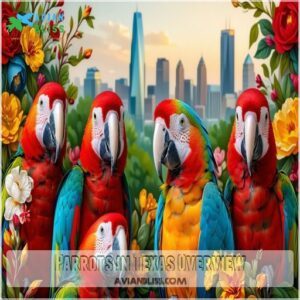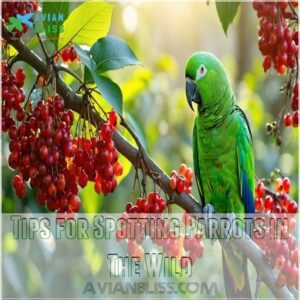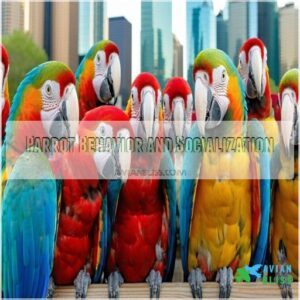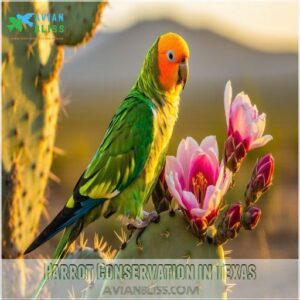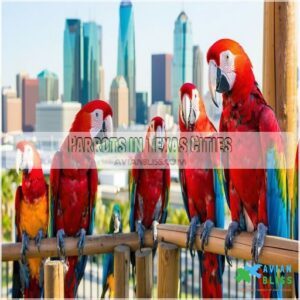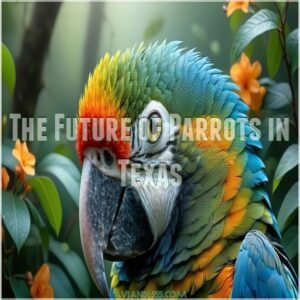This site is supported by our readers. We may earn a commission, at no cost to you, if you purchase through links.

These vibrant birds aren’t just vacation tourists—they’re making themselves at home across the Lone Star State.
While endangered red-crowned parrots huddle in the Rio Grande Valley and invasive Monk Parakeets commandeer urban utility poles, Texas provides a surprisingly welcoming habitat.
With around 900 red-crowned parrots fighting to survive, these feathered friends face challenges like habitat loss and illegal pet trade.
From Brownsville to McAllen, you’ll find these intelligent creatures adapting to city life, building complex social networks, and proving that everything’s bigger—and more interesting—in Texas.
Want to know more about these wing’d wonders?
Table Of Contents
- Key Takeaways
- Parrots in Texas Overview
- Red-Crowned Parrots in Texas
- Monk Parakeets in Texas
- Where to See Parrots in Texas
- Can You Own Parrots in Texas?
- Parrot Behavior and Socialization
- Parrot Conservation in Texas
- Parrots in Texas Cities
- The Future of Parrots in Texas
- Frequently Asked Questions (FAQs)
- What is the Best Way to Attract Parrots to My Backyard?
- Are There Any Health Risks Associated With Parrots?
- What is the Best Way to Safely Handle a Parrot?
- What is the Best Food to Feed a Parrot?
- Are There Any Laws or Regulations I Should Be Aware of Before Owning a Parrot?
- Are there any parrots in Texas?
- Why are there wild parrots in Austin?
- Can you own parrots in Texas?
- Are monk parrots native to Texas?
- Where to see parrots in South Texas?
- Conclusion
Key Takeaways
- Texas parrots: You’ll find Texas hosting around 900 red-crowned parrots and several other parrot species, with Monk Parakeets and urban populations thriving in cities like Austin and Houston despite challenges of habitat loss and illegal pet trade.
- Unique habitats: The state offers unique parrot habitats, particularly in the Rio Grande Valley, where these birds have adapted remarkably well to urban environments, building complex social networks and demonstrating incredible resilience.
- Wild parrot viewing: If you’re interested in seeing wild parrots, you’ll want to explore early morning or evening hours in cities like Brownsville, Austin, and McAllen, where guided tours and birdwatching events can help you spot these colorful creatures.
- Parrot ownership in Texas: Owning a parrot in Texas requires navigating specific legal requirements, including obtaining permits from the Texas Parks and Wildlife Department, understanding health certificate needs, and committing to long-term care for these intelligent, social birds.
Parrots in Texas Overview
You might be surprised to learn that Texas is home to a fascinating variety of parrots, ranging from wild species to escaped pets.
These colorful birds, thriving in the state’s warm climate and urban spaces, showcase just how adaptable and resilient nature can be.
Native Species Vs. Introduced Species
Parrots in Texas are a mix of fascinating origins.
While native parrots in Texas, like the endangered Red-crowned Parrot, thrive mostly in the Rio Grande Valley, introduced species shake things up:
- Monk Parakeets, hardy newcomers, build massive nests in urban areas.
- Exotic wild parrots thrive due to Texas’ habitat suitability.
- Competition and invasive impacts create ongoing conservation challenges.
Curious yet?
Conservation Status of Parrots in Texas
Texas hosts a vibrant mix of endangered parrots and thriving newcomers.
The red-crowned parrot, once native like the extinct Carolina Parakeet, is endangered due to habitat loss and the pet trade.
Meanwhile, the monk parakeet thrives amidst urban sprawl.
Ongoing conservation efforts balance protection and coexistence. Supporting parrot conservation can be achieved through Texas parrot conservation products(Texas parrot conservation).
Safeguarding these birds requires teamwork—governments, communities, and bird enthusiasts must unite to protect Texas’s diverse parrot populations and their future outlook.
Threats to Parrot Populations in Texas
It’s not all sunshine for Texas parrots. These colorful birds face real challenges:
- Habitat loss: Urban sprawl gobbles up their nesting spaces.
- Illegal trade: Pet traffickers raid nests, exploiting demand.
- Climate change: Shifting weather patterns stress their survival.
- Disease: Outbreaks can wipe out flocks overnight, devastating populations.
- Monk Parakeets, a prominent invasive species, also pose an ecological impact on native birds, making conservation efforts more complex, especially in managing invasive species’ roles.
These threats demand urgent attention to protect parrot populations.
Red-Crowned Parrots in Texas
You’ll find red-crowned parrots thriving in Texas, especially in the Rio Grande Valley, where their noisy gatherings light up neighborhoods.
These colorful birds, native to Mexico but now calling Texas home, rely on urban trees and palms for nesting and foraging.
Habitat and Distribution
Red-crowned parrots thrive in the Rio Grande Valley, taking full advantage of Texas’ mild climate and lush greenery.
They favor urban neighborhoods with tall palms for nesting, often near parks or spots brimming with food like berries or nuts.
As dusk falls, you’ll find them flocking together in loud, social gatherings, painting the evening sky with vibrant life.
Behavior and Social Structure
You’ll love watching their world unfold—the bold mating rituals, where pairs belt out loud duets and show off their feathers like performers in a spotlight.
Their strict social structure keeps the flock in line, with parrots also using head bobbing signals to communicate affection or tension.
Their competitive chatter for resources, coordinated flocking behavior at dawn, leadership roles shaping daily movement, and playful yet disciplined interactions showcasing sharp parrot communication skills. Community here means everyone’s got a role!
Conservation Efforts and Protection
Conservation is on the move. Groups across Texas are tackling issues like habitat restoration, ethical trade, and legal protections to keep these endangered parrots thriving.
Community action? It’s fundamental, with birdwatchers, schools, and researchers rallying to protect parrot populations.
Just consider their fate compared to the extinct Carolina Parakeet.
| Effort | Impact |
|---|---|
| Habitat restoration | Expands parrot ranges |
| Legal protections | Discourages trafficking |
| Citizen projects | Tracks parrot trade |
Monk Parakeets in Texas
You’ve probably spotted Monk Parakeets in Texas—those little lime-green birds building huge stick nests on utility poles.
These adaptable parrots have made themselves at home in cities like Austin and Houston, thriving among both urban sprawl and bustling neighborhoods.
Adaptation to Urban Environments
Monk Parakeets have embraced urban environments like pros. They munch on easy snacks from bird feeders or dumpsters and build massive stick nests on power structures. These feral parrots thrive amidst human interaction. Their nesting habits and urban parrot diets adapt to bustling cities, proving they’re tough birds. Who knew parrots could handle Texas traffic?
- Urban parrot diets include birdseed and scraps.
- Nesting habits involve intricate stick nests.
- Population density helps their survival.
- Human interaction doesn’t scare them away.
- Disease risks come from close contact with people.
Impact on Local Ecosystems
Watching urban parrots thrive might be fun, but feral parrots aren’t all charm. Here’s how Monk Parakeets stir things up:
- Parrot diet pressures: Wild parrots in Texas outcompete native birds for favorite seeds and fruits.
- Habitat alteration: Their bulky nests damage trees and weigh down power lines.
- Disease risk: They spread avian diseases, stressing native parrot populations and local wildlife.
- Seed dispersal disruption: Competing for seasonal resources leaves native birds struggling during migration, which can be further exacerbated by ecosystem disruptions like those seen in Hurricane Harvey’s aftermath.
Where to See Parrots in Texas
You’ll find parrots in some of Texas’ most unexpected spots, from urban neighborhoods to lush parks.
Keep an eye (and ear) out in cities like Austin, Houston, and the Rio Grande Valley, where their vibrant colors and chatter bring a tropical vibe to the Lone Star State.
Popular Spots for Parrot Sightings
If you’re chasing wild parrots in Texas, pack your gear for the Rio Grande Valley, where Brownsville boasts vibrant Red-crowned flocks.
Around Austin and Houston, Monk Parakeets steal the show.
For a snapshot-worthy adventure, explore these parrot hotspots during early mornings or evenings.
Check out the table below for the top Texas locations and best viewing times:
| City | Common Texas Parrots | Best Viewing Times | Photography Tips | Expert Advice |
|---|---|---|---|---|
| Brownsville | Red-crowned Parrots | Sunrise, Sunset | Use telephoto lenses | Visit quiet areas |
| Austin | Monk Parakeets | Early Morning | Stay still, avoid flash | Check urban trees |
| Houston | Monk Parakeets | Evening | Focus on tree canopies | Look near feeders |
| McAllen | South Texas Parrots | Dawn | Capture flight patterns | Avoid loud noises |
| Harlingen | Wild Parrots Texas | Dusk | Seek natural lighting | Hire local guides |
Guided Tours and Birdwatching Events
Explore Texas’s vibrant parrot species by joining guided tours or birdwatching events designed for enthusiasts.
- Research tour operators who promote ethical birding and respect wildlife habitats. Local reviews can offer great insights. Get up to speed on Texas parrot species to enhance your experience during tours. Knowledge pays off!
- Many events include photography workshops, so pack your camera and pick up skills to capture amazing shots.
- Consider volunteering opportunities tied to conservation. Birdwatching with a purpose makes the experience more rewarding (and impactful).
- Learning about Green Birds of Texas will enhance your birdwatching experience, especially if you’re new to the hobby.
Tips for Spotting Parrots in The Wild
Early mornings are the best viewing times for wild parrots in Texas.
Focus on trees with berries or nuts in urban parks and suburbs—ideal habitats for these vibrant birds.
Consider using a Texas parrot spotting guide to learn parrot calls to aid sound identification.
Learn parrot calls to aid sound identification and wear muted colors for better camouflage.
Always practice ethical viewing by staying quiet and respecting their space while enjoying Texas wildlife.
Can You Own Parrots in Texas?
Owning a parrot in Texas is legal.
Specific rules apply, including permits and health checks.
With their long lifespans and active personalities, parrots can be rewarding but demanding companions.
Laws and Regulations Regarding Parrot Ownership
Owning a parrot in Texas isn’t just about picking one out and bringing it home—Texas parrot laws are strict.
You’ll need to navigate permit requirements and understand which species are prohibited.
Licensing fees vary, and owning illegal parrots in Texas could lead to hefty legal penalties.
Ethical considerations also matter, especially with concerns about parrot smuggling in Texas threatening wild populations.
Permits and Licenses Required
Bringing a parrot home in Texas isn’t just a casual decision—it’s a commitment with legal steps.
- Apply for a permit through the Texas Parks and Wildlife Department.
- Get a health certificate to prove your parrot’s in good shape.
- Cover the permit costs (typically $20-$50 annually).
- Renew your permit every year, staying on top of Texas parrot laws.
- Check rules in your area to avoid issues with illegal parrots or parrot smuggling.
Plan ahead—your feathered friend deserves it!
Responsibilities and Challenges of Parrot Ownership
Caring for a parrot is a marathon, not a sprint. These long-lifespan birds need mental stimulation, vet care, and spacious housing. They’ll outlive most pets, so plan ahead.
Here’s a quick glimpse:
| Challenge | What to Expect | Solutions |
|---|---|---|
| Noise Levels | Loud squawking anytime | Train for quiet commands |
| Housing Needs | Large cage, daily freedom | Invest in bird-friendly areas |
| Health Issues | Regular vet check-ups needed | Find exotic pet specialists |
Parrot Behavior and Socialization
You’ll notice Texas parrots are anything but shy, often flocking noisily in large groups.
They show off their vibrant personalities.
From competitive squabbles to synchronized duets, they’ve mastered the art of communication and thriving in their adopted neighborhoods.
Flocking Behavior and Communication
In Texas, parrots thrive in tight-knit flocks, bonding through vocal magic. Their communication includes:
- Parrot calls signaling food or danger.
- Social signals keeping group cohesion strong.
- Unique communication methods like duets during mating.
- Flock dynamics encouraging teamwork in foraging.
Unfortunately, these birds face threats like parrot poaching in Texas, which can disrupt their social behaviors.
These fascinating behaviors highlight the smarts and adaptability of parrots in Texas.
Mating and Breeding Habits
Parrot breeding habits are a spectacle of charm. From lively dances to sweet calls, courtship rituals are intricate.
During breeding season (spring), parrots in Texas choose mates and craft nests with precision. Here’s a peek at their process:
| Step | Description |
|---|---|
| Nest Building | Crafting homes in tree cavities |
| Courtship Rituals | Singing, dancing, gift-giving |
| Egg-laying | 2-6 eggs per clutch |
| Chick Rearing | Parents share feeding responsibilities |
The courtship rituals are a key part of Parrot breeding habits. Egg-laying and chick rearing follow nest building.
Social Structure and Dominance Hierarchy
Flock dynamics in Texas parrots are like a bustling city—some lead, others follow.
These vibrant flocks feature a clear social structure, with dominant birds claiming prime perches or food spots, often causing hierarchy disputes.
Resource competition is fierce, especially during breeding hierarchy battles.
Providing a variety of Texas parrot toys can help alleviate stress and boredom in a flock.
Watching their subtle behaviors feels like glimpsing a tiny, feathered soap opera in action!
Parrot Conservation in Texas
You can help keep Texas’s parrots safe by supporting efforts to protect their habitats.
protect their habitats and monitor their populations.
From community programs to research projects, every action plays a part in ensuring these vibrant birds continue to thrive.
Efforts to Protect and Preserve Parrot Habitats
Protecting parrot habitats starts with habitat restoration and community action.
Join local tree-planting events or support wildlife groups tackling habitat loss.
Push leaders to fund parrot conservation and enforce legal protections.
It’s about teamwork—your voice boosts awareness of future threats.
Together, we protect Texas’s vibrant parrot populations and their wild, noisy homes for generations.
Research and Monitoring of Parrot Populations
Scientists examine population trends to spot red flags in parrot numbers.
They also explore genetic diversity, gaining clues for smarter conservation strategies.
Finally, habitat mapping helps pinpoint key zones for Texas parrots like Monk Parakeets.
These efforts aren’t just science for science’s sake—they’re essential steps to understanding and protecting the vibrant psittacidae flourishing across the state.
Community Involvement and Education
Getting hands-on with citizen science projects like community surveys boosts parrot conservation efforts.
Volunteer programs and educational outreach connect people to the cause.
Support habitat restoration, raise awareness about ethical parrot ownership, or back local parrot sanctuaries—every small action counts.
Parrots in Texas Cities
You’ve probably noticed parrots making themselves at home in Texas cities, from bustling neighborhoods to leafy parks.
These vibrant birds have adapted surprisingly well to urban life,
often turning utility poles and palm trees into perfect perches.
Urban Adaptation and Habitat Use
Parrots in Texas cities have mastered urban living, turning concrete jungles into thriving habitats.
Their urban foraging strategies include raiding bird feeders, nibbling on backyard fruit trees, and scavenging scraps.
They demonstrate creative nest site selection, building homes out of twigs, wires, and even utility poles.
Parks, gardens, and shaded neighborhoods are their go-to spots, proving that habitat fragmentation effects don’t faze these clever birds. Monk and Nanday Parakeets especially flourish in these human-made environments.
Conflicts With Humans and Infrastructure
Texas’s vibrant parrots, like Monk Parakeets, thrive in urban environments but often ruffle feathers.
Nesting disputes arise as parrots use infrastructure like power lines for roosting, leading to electrical outages or even fires.
Their squawking sparks noise complaints and distracts drivers, causing accidents.
Habitat loss forces parrots closer to human areas, fueling food competition.
Illegal parrots from smuggling worsen conflicts as they adapt too well to city life.
| Conflict | Details |
|---|---|
| Nesting disputes | Damage from nests on poles and wires. |
| Power line hazards | Infrastructure risks and power outages. |
| Noise complaints | Constant loud squawking annoys residents. |
| Habitat loss | Pushes parrots into crowded spaces. |
| Food competition | Parrots raid gardens, bird feeders. |
Opportunities for Conservation and Education
- Volunteer for community outreach programs sharing parrot conservation tips.
- Join citizen science projects tracking wild parrot populations.
- Support habitat restoration efforts improving parrot habitats in Texas.
- Advocate for endangered parrots in Texas through funding opportunities or ethical trade policies.
Recognize the importance of preserving natural habitats, such as those of Quaker Parrots in the wild.
Even small actions build big wins!
The Future of Parrots in Texas
You’ve probably noticed Texas’ vibrant parrot populations aren’t slowing down.
Their future depends on how we tackle mounting conservation challenges.
With threats like habitat loss and climate change, balanced efforts from communities and governments will be vital to keeping these colorful birds thriving.
Threats and Challenges to Parrot Populations
Parrots in Texas face obstacles that could cripple their growing populations.
Habitat loss shrinks nesting spaces and food sources, while climate change stirs up unpredictable migration and harsh weather.
The illegal trade snatches birds straight from their homes, hurting numbers further.
Then there’s disease outbreaks, which isolate flocks and take a deadly toll.
Balancing booming urban growth with parrot conservation is no joke—Texas birds need a safety net, fast.
Conservation Strategies and Initiatives
Conservation biology is buzzing in Texas with parrot-focused efforts. Think habitat restoration, legal protections, and tackling parrot smuggling in Texas.
Want to help these endangered parrots?
Here’s how to join the movement:
- Support wildlife conservation groups with funding needs.
- Join parrot conservation efforts via citizen science.
- Report illegal parrot activity.
- Promote community outreach and education.
- Advocate for stronger legal protections.
Role of Community and Government in Parrot Conservation
Every Texan can be a parrot protector through community-driven conservation.
Join local monitoring programs, create parrot-friendly landscapes, and spread awareness about wildlife preservation.
Government regulations provide a framework, but community involvement is the real game-changer.
By supporting habitat restoration and joining citizen science initiatives, you’ll help these vibrant birds continue to thrive across the Lone Star State.
Frequently Asked Questions (FAQs)
What is the Best Way to Attract Parrots to My Backyard?
Dreaming of feathered friends?
Attract parrots by setting up native fruit-bearing trees, offering specialized seed mixes, and creating safe, quiet spaces with bird baths.
Install sturdy feeders away from predators and watch your backyard transform into a parrot paradise.
Are There Any Health Risks Associated With Parrots?
You’ll want to watch out for psittacosis, a respiratory disease parrots can carry.
Salmonella, avian flu, and allergic reactions are potential risks.
Always practice good hygiene, wash hands, and get regular vet check-ups for your feathered friend.
What is the Best Way to Safely Handle a Parrot?
When handling parrots, wear gloves, move slowly, and support their body.
Talk softly, approach from the side, and let them step onto your hand willingly.
Watch for body language signals that indicate comfort or stress.
What is the Best Food to Feed a Parrot?
Serve your parrot a balanced diet of high-quality pellets, fresh fruits, and veggies.
Mix in nuts and seeds sparingly.
Avoid avocado, chocolate, and caffeine—they’re toxic.
Consult an avian vet for personalized nutrition advice.
Are There Any Laws or Regulations I Should Be Aware of Before Owning a Parrot?
You’ll need permits from Texas Parks and Wildlife, plus a health certificate.
Budget $20-$50 annually for licensing.
Check local regulations, and prepare for a decades-long commitment with your feathered friend’s complex care needs.
Are there any parrots in Texas?
Like colorful feathered squatters, Texas hosts eleven wild parrot species!
You’ll find these exotic birds thriving in urban areas, from Houston to the Rio Grande Valley, with Monk Parakeets leading the tropical takeover.
Why are there wild parrots in Austin?
Wild parrots thrive in Austin.
They’ve adapted brilliantly, finding food in dumpsters and nesting in trees.
This is thanks to the city’s mild climate, urban vegetation, and escaped pets, creating a quirky urban wildlife scene.
Can you own parrots in Texas?
You’ll need a permit from Texas Parks and Wildlife, plus a health certificate.
Annual fees range $20-$
Check local regulations, as requirements vary.
Remember, parrots are a decades-long commitment that demands serious dedication.
Are monk parrots native to Texas?
Monk parrots aren’t native to Texas—they’re escapees from the pet trade.
These lime-green and white birds have made Texas urban areas their home, thriving in cities like Houston and Austin without being originally from here.
Where to see parrots in South Texas?
Spread your wings like a wild parrot in the Rio Grande Valley!
Peek into Brownsville’s urban parks.
Scout the Quinta Mazatlan in McAllen.
Join local bird watching tours to spot these vibrant feathered friends.
Conclusion
Like a vibrant tapestry woven across the Lone Star State, parrots in Texas tell a story of resilience and adaptation.
You’ll find these feathered survivors traversing urban landscapes and wild habitats, challenging expectations at every turn.
From the endangered red-crowned parrots of the Rio Grande Valley to the resourceful Monk Parakeets, these birds aren’t just existing—they’re thriving.
Your curiosity and support can help safeguard their continued success in this unique Texas ecosystem.

